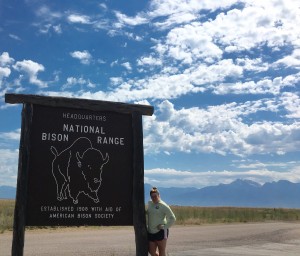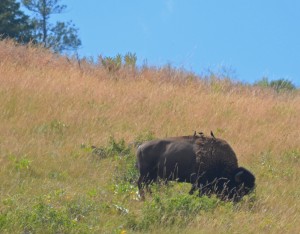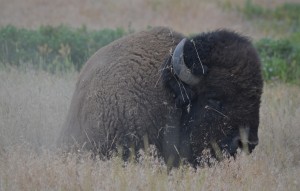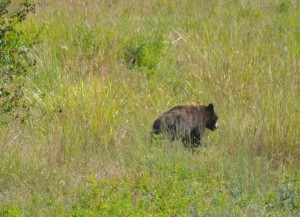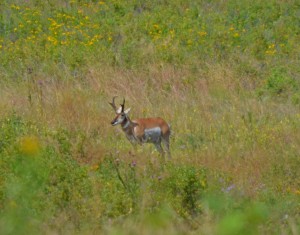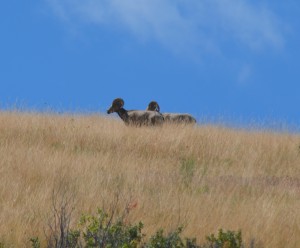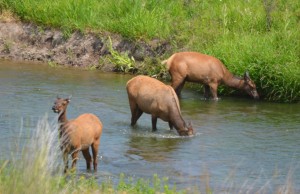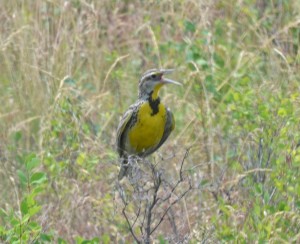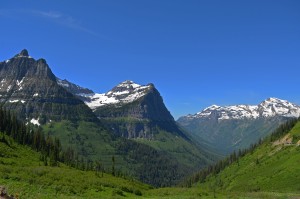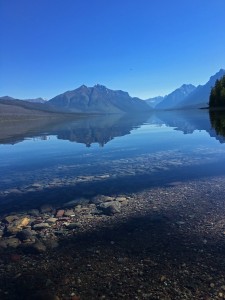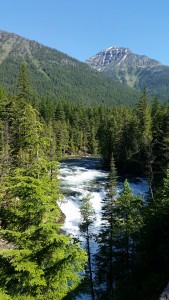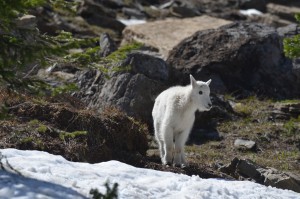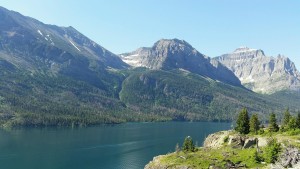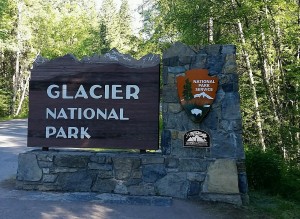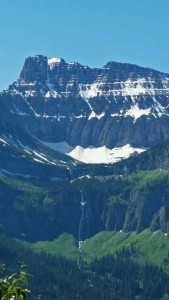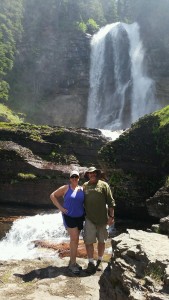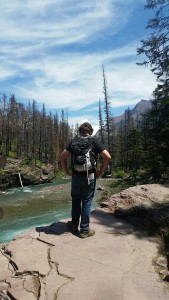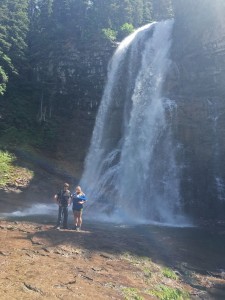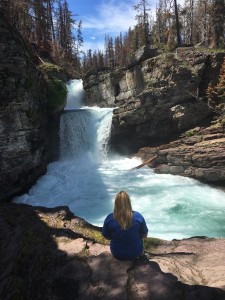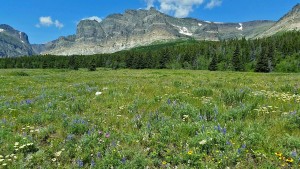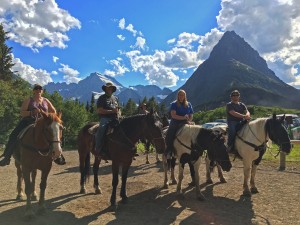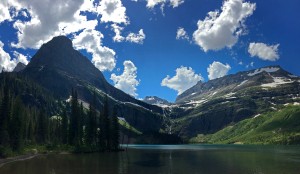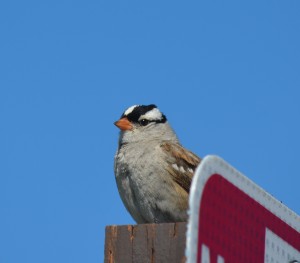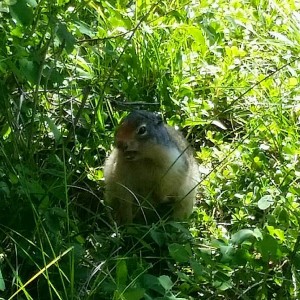June 26 – 11:30am
After driving east from Olympic National Park for 2.5 hours, and bouncing along a dirt road for the final 25 miles, we were only about 4 miles shy of the trailhead that would be the start of our hike to our destination that day-Mt Rainier. As we drove by 50 other cars, we realized the road was blocked off with a Park Ranger sitting in his truck eating his lunch, and guarding a barricade. Not what we wanted to see. I walked up to ask him about the road ahead, and he paused for a minute after taking a bite of his ham sandwich, wiped the mustard off his mouth, and said, “Nope, the road’s not open yet. Maybe tomorrow or the next day. There’s still a couple feet of snow they’re trying to clear,” and with that, I thanked him and walked back to the car. New plan. We’ll have to drive another 2 hours and enter Mt Rainier National Park from the south.
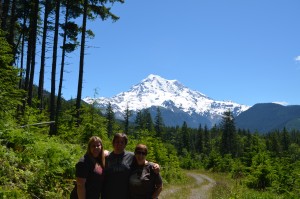
Our first real look at Mt Rainier from the north, Our plans changed when the access road we wanted to use was still not open due to snow.
3:00 pm
Lots of people visiting Mount Rainier today-it’s packed! After several minutes of cruising the crowded Paradise Visitor Center parking lot like a hungry shark looking for its next meal, we finally caught a break when a nice lady from Minnesota “reserved” her space for us as her husband backed their big pick-up truck out. The mountain awaited our arrival.
3:30 pm
We gathered our souvenirs from the gift shop, and headed outside. The Skyline Trail started directly behind the visitor center-lots and lots of people were trying to squeeze on to the 6’ paved trail that led up to our goal 4.5 miles away, called Panaroma Point, elevation 6,800’. At 14,410’ above sea level, Mount Rainier stands as an icon in the Washington landscape. An active volcano, Mount Rainier is the most glaciated peak in the lower 48 states, and is the headwaters for six major rivers.
3:35 pm
As we begin our hike, I understood why so many people were stopped along the trail only a few hundred yards from the trailhead. It was very steep-about a 20% grade for the first ½ mile. Wow! I know I’m not in great shape, but I was not ready for the immediate rise of this trail. This trail “slaps you in the face” right from the first step. For me, it tested my physical fitness level before my mental fitness level ever knew what was happening! Fifteen minutes into our walk, my calves were burning and I could barely catch my breath. Maybe it was the thin air, or maybe it was just that last handful of Doritos I gobbled down with my turkey sandwich at lunch! But whatever the reason, I knew this “nice little hike” was going to be a real challenge for me. When I was writing this blog, and thinking about photos for it, I asked Darby if she had snapped any pictures showing this steep walk with all the other people. Her response, was “are you kidding, I was too busy trying to breathe!”
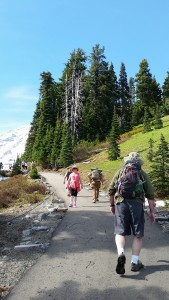
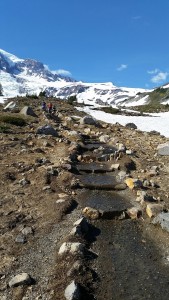
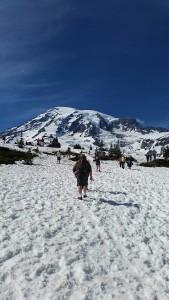
3:55 pm
My enthusiastic pace has slowed considerably. I feel my Bighorn Sheep-like tempo is beginning to resemble a Sloth. Twenty minutes in and my legs feel like lead weights. I did manage to pass several people wearing flip-flops and four baby strollers. Theresa is just ahead of me, but Tyler and Darby are at least ¼-mile out in front.
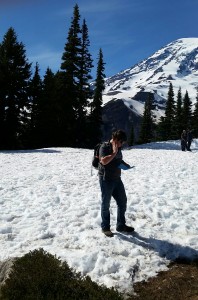
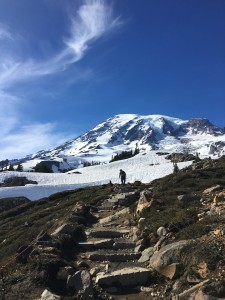
Tyler checks the map in the 1st snowfield to see if we’re even close to the hidden trail, then continues out in front.
4:15 pm
In full view now, Mount Rainier is getting larger and more majestic with each step. After what seemed like 57 stops to catch my breath, and nearly drinking all my water in less than a mile, the marked, paved trail is gone. We were now hiking through a snow field. It’s pretty cool to be hiking through snow, in shorts and t-shirts in June. Most of the crowd decided to turn back when the pavement ended, or they simply couldn’t breathe, whatever the reason, only a few dozen adventurers continue on now.
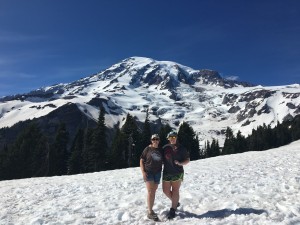
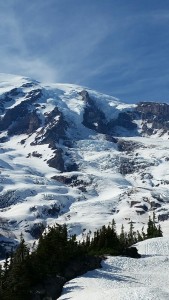
4:45 pm
The soft, melting snow makes for some tough walking. It’s similar to trudging through deep, dry sand at the beach, except colder. There’s no trail to follow now, so, like Caribou migrating across the tundra, we follow each other, and the footprints of others who have gone before us. We have to move to the side as several climbers who have successfully reached the summit a few hours before, are now skiing their way back down the mountain as far as the snow stretches.
5:20 pm
We’ve managed to reach a small viewing area called Avalanche Point. This is as far as we can realistically go without proper snow climbing gear, such as crampons and trekking poles. Panaroma Point is still high above us-about another 1.5 miles hiking through a steep, snow-covered trail. Nope, this is as close to Mt Rainier as we’re going to get today. But, it’s still an awesome vista. As we turn around, looking back down the mountain, we can clearly see Mt St Helens and Mt Hood in the distance.
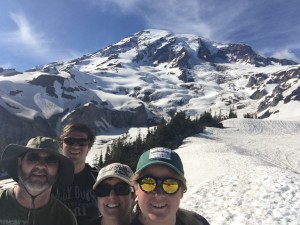
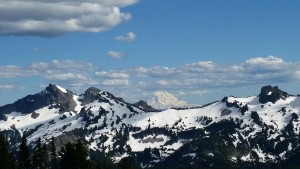
A selfie at Avalanche Point, and a look at Mt St Helens in the distance.
5:50 pm
We begin our descent back down the mountain, deviating from our route up. We think we found what is supposed to be the marked trail, as we dance our way down through the soft, melting snow. It’s actually kinda fun as we slip, slide and take a tumble or two. As I try to show-off my slick mountaineering skills, I suddenly lose my footing and come crashing down in a heap. A little embarrassed and with 2 pounds of snow now down my pants, I pick myself up and continue walking, trying to act like nothing happened! I don’t think anyone saw me, except for the six teenagers laughing and all pointing their cell phones at me. We stop for a brief rest and hear whistles echoing from the bare patches of alpine meadow-Marmots. These high elevation rodents communicate to each other through a series of whistles, like someone whistling to their dog.
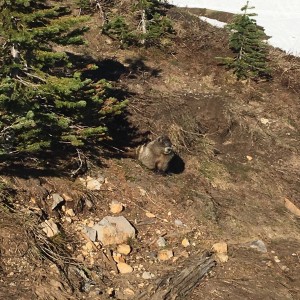
6:30 pm
We finally exit the snow fields and make our way back to the paved trail, eventually reaching the visitor center. It’s been a great hike through the snow to the base of one the largest mountains in the U.S. My knees are aching, I’m hungry and thirsty, but will always remember this “nice little walk” we took one day in late June to see Mt Rainier!
